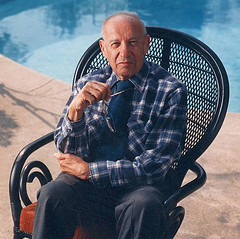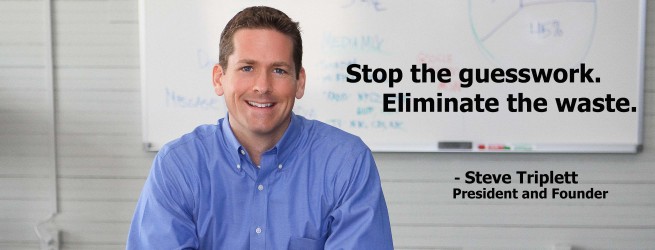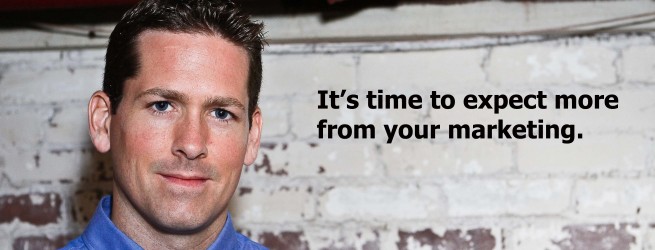What Advertising Cannot Do
Advertising is just one of many tools you need to market your business. It’s the process of communicating with your customers. While this is extremely important, it is by no means an end in itself. The reason I say this is because I often meet people that say things like “I tried advertising on TV and it didn’t work” or “Outdoor advertising has never worked well for my business…” The mistake that they are making is assuming that the media used is responsible for the success or failure of a campaign.
An advertising campaign cannot perform beyond the quality of its content. No matter where or how you spend the money, the results will always be proportional to the quality of the conversation you create with your customers. If your advertising campaigns are not generating the results you expect, start by analyzing the content of the message. Chances are that’s where you’ll find the most opportunity for improvement. Try coming up with multiple concepts and testing them with small, inexpensive ad schedules. Once you find a message that works, it’s very easy to amplify the results by spending more on an ad campaign that reaches more people.
Demand More Value
So things are slow right now and the economic forecasts show no sign of improvement. You have two choices – read the news all day long and wallow in the negativity or take advantage of the opportunities that volatility creates. No matter how bad things get people will still buy things and will seek out businesses that can provide a great value. At the same time, you need to demand more value from your partners and suppliers as well.
For the foreseeable future the supply of advertising inventory will significantly exceed demand. Consumer spending is down, advertisers are pulling back, and there are more options available than ever before to communicate with customers. For the intelligent marketer this is actually good news because it means you have the opportunity to squeeze more value from every dollar you spend*.
As you begin negotiating your advertising contracts for 2009 here are 5 things you can do to maximize your investments:
1) Demand lower rates.
The simple truth is that supply exceeds demand. The political spending is over and every other category is down. Even online spending forecasts are being revised downward. If your media partners are telling you that rates must go up, it’s time to find other partners.
2) Expect added value.
Most media vendors have plenty of incentives they can offer you in addition to paid inventory. Ask for features, sponsorships, preferred placement, bonus advertising, promotional opportunities, third-party partnerships, links, mentions, category exclusivity etc.
3) Expect preferred placement.
We’ve all heard of under-booked airlines, hotels, and cruise ships offering free upgrades to passengers. As a loyal advertiser you should expect the same type of VIP treatment from your media partners. Ask for larger ads, higher traffic locations, higher-rated programming, better daypart rotation, or prime positioning at no additional charge.
4) Expect more favorable terms.
Avoid restrictive contracts. The market is turbulent and you need to remain agile. Getting locked into anything restricts your ability to rapidly adapt to changes. Make sure that all contracts can be revised or canceled with reasonable notice. Ask for discounts for timely payment i.e. within 15 days, 30 days etc.
5) Expect better service.
If you only hear from your sales reps when it’s time to renew it might be time for a change. A good salesperson should keep you informed about your campaign, offer ideas and research, and care about the success of your business. Let them know what your goals and expectations are and ask for their ideas on how to get there.
Please note – this is NOT about beating up your partners. A strong working relationship with your vendors is essential and will pay dividends. At the same time, it would be irresponsible to not take advantage of the opportunities that a slow market creates for advertisers. If you do not raise your hand and ask for these incentives then they will go to someone else. Ask nicely and be sure to remind your sales reps that any extra value they can provide now will come back to them in the form of increased budgets as your business grows.
How Do Your Fees Work?
There are several compensation structures we offer clients based on the type and scope of work they need. Here are the common arrangements:
Commission Based
For clients that utilize traditional media i.e. television, radio, outdoor, print and other offline media, our fees are usually completely covered by the discounts we receive from our media vendors. The standard agency discount is 15%. Here’s how it would work with a hypothetical budget of $10,000:
- We purchase $10,000 worth of advertising inventory on behalf of you, the client.
- At the conclusion of the campaign, the media vendors invoice our agency for $8,500 (a 15% discount).
- The remaining $1,500 covers the agency fee.
Clients like this arrangement because they end up getting our services without spending any additional money. It works really well for situations where clients use us primarily to manage their media planning and placement.
Retainer Based
For comprehensive consulting services and/or situations where media commissions are impractical, we work on a flat monthly retainer. Depending on the scope of work, these fees range from $3,500-$15,000 per month.
There are also instances where clients prefer to hire us to work only on specific aspects of their marketing program. In these cases, we offer a reduced-rate retainer based on the scope of work. Typical examples of this would be pay-per-click marketing, social media consulting, email marketing management etc. The management fees for these services start at $1,500/month.
Retainer Plus Commission Based
For clients with full-service consulting needs and extensive media plans we often work out a flat monthly retainer plus media commission arrangement.
Project Based
Sometimes clients just need us to do a specific project i.e. build a website, design a logo, write a sales letter, etc. In these instances we are happy to quote a flat fee for the project.
Drucker's Wisdom

Marketing and innovation produce results; all the rest are costs.
-Peter Drucker
Mixing Old and New Media
A while back I wrote this post about choosing an allocation strategy for online vs. offline media. My point was that it’s not such a good idea to write off anything that might be considered “old media” in favor of “new media” just because it’s fashionable at the moment. One of the main reasons for this is that large sections of the population are still relatively disengaged with the internet compared to the much smaller segment that can be considered fully engaged or “hyperconnected.” Steve Rubel has a great post on this that further illustrates the point.
Digital Insight
Razorfish recently released their 2009 Digital Outlook Report. It’s 180 pages long but well worth the read as it provides some great insight into current trends in digital marketing. You can view/download the whole thing here. If you have a short attention span there’s a nice summary here. Enjoy!
What We Can Learn From Pepsi
For over 20 years, Pepsi bought TV commercials during the Super Bowl. This year they are abandoning it and reinvesting the $3 Million or so per commercial they’ll be saving in various online initiatives.
This is important for several reasons. For one thing, Pepsi is a huge company. It’s not like they have to choose between the TV ads and the online projects – they can easily afford to do both. By choosing to drop a strategy that’s been a staple of their marketing for decades, Pepsi is indicating that it’s simply not a profitable investment for them. The fact is that no matter how funny or clever the commercial is, you’ve got to sell an awful lot of soda to cover the millions spent to produce it and the $100,000 per second it costs to run it.
The other reason it’s important is because Pepsi falls into one of the categories that many advertising “experts” seem to think can only be marketed effectively through high-concept “branding” campaigns. In reality, what’s being discovered is that no matter how big or commoditized a product may be, the Internet provides a plethora of ways to engage in two-way dialogue with customers that is much more valuable than the dubious results of bombarding them with cute TV spots.
Chances are, your company doesn’t have the resources that Pepsi does. You may not even have the resources your competitor does. 10 years ago, that kind of thing mattered a lot more than it does today.
The most important thing you can possibly do to grow your business is earn the right to communicate directly with your customers. Build your database by creating products and experiences that people want to be a part of. Create something worth finding. Give your customers a place to talk about your brand and them let them know you are listening. All of this can now be done online for a fraction of what it costs to out-shout your competitors with boring ads promoting free consultations, low prices and convenient locations.
Pepsi is doing it. You can too.
Smith & Stallworth
Legal marketing can be quite challenging. For one thing, lawyer advertising is closely regulated by each state’s respective Bar Association. Without going into excessive detail, many of the concepts and much of the language you might typically employ in marketing messages is forbidden in legal advertising. All copy must be submitted to the Bar for approval and they have no problem responding with a long list of revisions to be implemented before they will give their blessing to run the ad.
The regulatory hurdles are just one of the factors that contribute to the general lack of quality you see in lawyer advertising. The other problem is that attorneys, like most business owners, tend model their advertising efforts after those of their peers. Ever wonder why so many legal advertisements feature a lawyer sitting in front of a bunch of law books? Because that’s what everyone else does. Ever wonder why lawyers all talk about how “aggressive” they are or how many years of “experience” they have? Because that’s what everyone else does. And don’t get us started on production quality; how many times have you seen attorney commercials that look like they were shot on a cheap VHS camcorder? If that’s what everyone else does it must be sufficient right?
Differentiation is a key component of a successful marketing campaign. In many cases it can be difficult to find new ways to truly carve out a unique position for a particular business. But sometimes, you can make quite a statement by just looking around at what all your competitors are doing and exploiting an obvious weakness.
The law firm of Smith and Stallworth is one of Tampa Florida’s newest and fastest growing law firms. Courtney Smith and Mark Stallworth are not only outstanding attorneys, but all-around great guys as well. Here’s a sample of the TV creative we recently developed as the first part of a comprehensive campaign to introduce them to their home market.
Using URLs in ads
Most marketers include phone numbers in their ads. It’s intuitive to do so and appeals to that most primal of all marketing urges – the desire for an immediate phone call in response to an ad exposure. But, as readers of this blog know, the process of earning new customers usually involves multiple steps between the initial exposure and the first transaction. One of the most important stops along the way occurs when someone is encouraged to visit your website for more information. While it’s not unusual to see URL’s in advertisements these days, it is still fairly common to see basic formatting mistakes that can make it difficult for interested consumers to note the address. Here are a couple of very simple guidelines to keep in mind when placing URL’s in your advertisements:
- Do not use all caps to display your URL. Despite the fact that it looks bad, it’s also harder to read and generally looks unsophisticated.
- It’s okay to skip the “www” part if you want a cleaner look. Most people get that URL’s begin with “www” and most browsers navigate to the right place without it anyway. If you want to get picky about it a full URL includes the whole “http://” thing as well but you hardly see that anymore do you?
- Use capitalization or other font treatments to seperate words. Unless you are lucky enough to have an address like IBM.com, you probably have several words in your URL. It’s asking a bit much to expect drivers passing a billboard at 65mph to decipher:
www.joesfriendlypoolcleaning.com
But if you capitalize you end up with a much easier to read:
www.JoesFriendlyPoolCleaning.com
Different colors or other font treatments also work well:
www.JoesFriendlyPoolCleaning.com
- When you include a URL in an advertisement, make sure that the landing page is strategically relevant to the ad. If someone sees your ad offering “buy-one-get-one-free cheeseburgers” and then types in the URL to find out more, they should be taken to a page with information on that offer. Don’t just send people to your homepage and expect them to dig around. Again, sounds simple but lots of businesses still get this wrong.
- Simplify, simplify, simplify. Once you start adding a bunch of forward slashes to your landing page address you might as well forget it. Nobody’s going to hear this on the radio and recall it later that night after dinner:
www.ClarkSmithMcDonald.com/freereports/taxplanningtips
Using subdomains is a better option:
TaxTips.ClarkSmithMcDonald.com
Campaign Specific URL’s are even better still:
TampaTaxTips.com
If you really want to use your homepage as the landing page for an offer make sure you include a button, banner, or other link that is prominently featured and will take your visitors where they need to go.
Electronic Measurement
Electronic measurement has been a hot topic in the world of broadcast media for some time now. Until fairly recently, TV and Radio audience measurement was tracked primarily through the use of written diaries that listeners/viewers filled out by hand (TV ratings usually combined diary results with a primitive set-tuning meter). As you might expect, this type of system is extremely susceptible to error.
It’s not like the average person is going to walk around with a notebook all week long taking copious notes on every interaction they have with the TV or radio. In practice it plays out more like this: At the end the day or week, the diary recipient fills in the diary by memory. Let’s say they are in the habit of listening to the radio each day as they get ready for work. So they fill in the 7a-7:45a time slots for each weekday and say that they listened to the morning show on channel ‘X’. The problem with this is that they did not actually get exposed to all of this programming because they were in and out of the shower, eating breakfast, blow drying their hair etc. while channel ‘X’ was on in the background. Yet the ratings will still reflect this as 3 hours and 45 minutes worth of listening for the channel ‘X’ morning show. This is just one simple example of many ways that ratings distortion can occur in a diary-based system.
Advertising agencies have been calling for a more accurate electronic measurement system for many years. As you can imagine, the very thought of changing the diary system is frightening to TV and radio companies because they know that they receive an artificial ratings boost from the diary system. So implementing the technology has been a long, slow battle between broadcasters, the ratings companies, and advertising agencies.
We have now reached the point where both Nielsen (the major TV ratings provider) and Arbitron (the major radio ratings provider) have developed electronic “people meters” that measure audiences by automatically tracking their listening and viewing habits. These systems are far from perfect but they do represent a significant increase in accuracy compared to the old methods.
As we gradually transition to these new measurement systems, advertisers should be aware of the effects of this new data on their media schedules. The most dramatic effect for both radio and television is a significant drop in Average Quarter Hour listening and viewing levels. In some cases these levels can drop by 50% or more. If you plan your broadcast buys by aiming for a certain level of gross ratings points delivered, you will need to adjust your expectations if your market is moving from diary-based to electronic measurement.
The good news is that nothing is really changing other than the accuracy of the numbers. If you were buying 100 gross ratings points for $25,000 using the old data, the same schedule/budget may now only deliver 75 gross ratings points. While it may seem like you are getting a lot less for your money, the reality is that you were never really getting the full 100 ratings points in the first place. It’s not the most pleasant thing to accept but at least we’re moving in the direction of improved accuracy.




